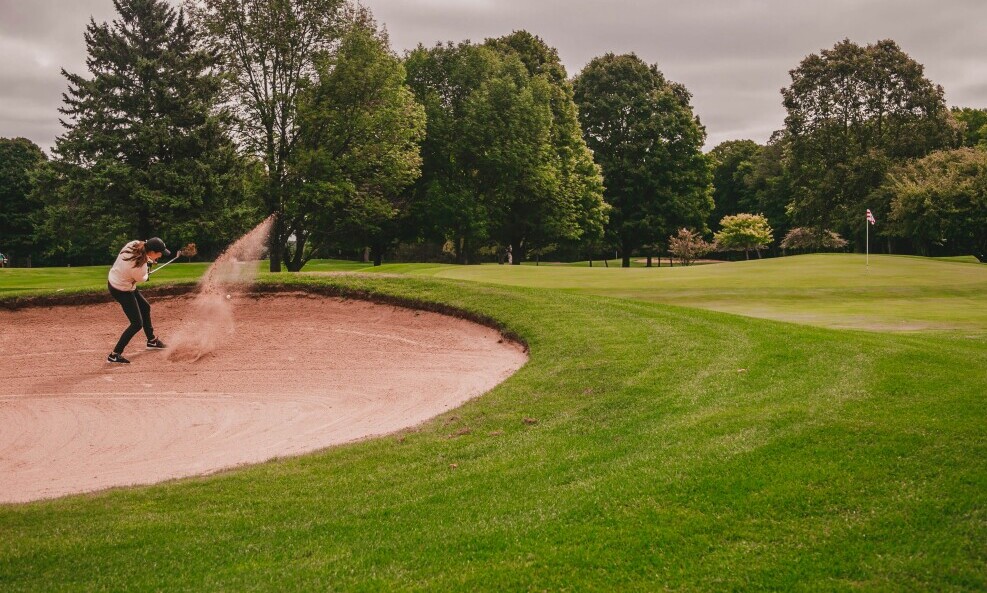What Is A Bunker In Golf?


Fore! Quick note: a few links here are affiliate links. If you snag gear through them, I earn a small commission — no extra strokes added to your game.
Bunkers in golf are those rugged patches of sandy terrain strategically placed to test a golfer’s skill and patience. They’re like nature’s practical joke, scattered around the course to catch you off guard. They can break you down and become your nemesis on the golf course, if you let them. The golf viking is here to help you keep that from happening. Today we’re talking bunkers.
Originally, they started as mere depressions in the ground, where sheep took shelter from the wind, and over time, evolved into the artfully designed sandy traps we see today. You’ll find different types, from pot bunkers that resemble mini craters to sprawling fairway bunkers that stretch along the greens, each with its own flavor of challenge.
Bunkers serve a dual purpose. On one hand, they’re obstacles, challenging your precision and strategic thinking. On the other hand, they add character to the course, making each one unique and memorable. Course designers are strategic in how they place bunkers, and you need to be just as strategic to handle them.
When you step onto a course, the placement of these bunkers tells a story. It’s the architect’s way of guiding you through a narrative, where every shot becomes part of a grander strategy. Positioning and design are all about pushing you to think creatively, perhaps nudging you to take risks if you’re feeling adventurous.
Despite the struggle they might provoke, bunkers are an integral part of golf’s charm. They balance the line between skill and frustration, ensuring no two rounds feel the same. Next time you’re on the green, you might just glimpse the allure in their sandy granules, understanding how they amplify the thrill of the game. So how are bunkers going to challenge your game?
A bunker is one of the most common hazards on the course. Learn how to escape tricky lies in how to hit out of rough, sand, and tough lies.
Ready to level up your golf game? Click here.

The Hazards of Bunker Traps: Challenges and Avoidance
Golfers often find bunkers a bit of a nuisance, and for good reason. Ending up in one is like meeting a speed bump that’s ready to throw your game off-balance. It’s not just about the physical barrier they present, but the mental chess game they play with you too.
Why does everyone suggest steering clear of bunkers if you can? Easy. They mess with your score. Every shot counts, and getting stuck in the sand can mean extra swings you weren’t planning on which means extra strokes on your scorecard. These sandy patches demand more than a regular shot, often leading even seasoned players into a bit of a jam.
Apart from affecting your scorecard, they test your flexibility and recovery skills. When you find your ball nestled in the sand, you’re left to tackle soft footing, tricky angles, and less forgiving flight paths. They will test your skill as well as your patience.
There’s a reason golf’s a mental sport too. Seeing your ball spin into a bunker can leave you doubting your strategy. The psychological edge it takes to pull off a clean escape isn’t something to be underestimated. Confidence is key, and bunkers often toy with that, making it crucial to manage these traps with a cool head. It’s hard to play a confident game from the bunkers.
Many players swear by course strategy to keep bunkers at bay—mapping their way around the course in ways that minimize risk. Some even say a solid defensive play can be just as rewarding as that perfectly executed shot over the hazard. But sometimes no matter how hard you try, you can still end up on the beach.
Focusing on strategic navigation to avoid these traps can pay dividends. By sharpening course management skills, focusing not just on power but precision, you’ll find yourself sidestepping these sandy roadblocks more often than not. So what’s the best way to play bunkers? By not getting in them in the first place. But should you find yourself stuck, let’s talk about how we can get out without too much of a dent to your score.
Your club selection matters when facing sand traps. Explore wedges and loft in what is loft in golf?

Mastering the Art of Escaping Bunkers
Getting out of a bunker isn’t just about luck; it’s about mastering a few key techniques and keeping your cool. I’m here to break down how to turn those sandy setbacks into smooth recoveries. Knowing you can recover from the bunkers will let you play more comfortably.
First up, club choice matters. Generally, you’ll want to reach for a sand wedge. Its design is meant for these scenarios, with a shape that helps pop the ball out with minimal fuss. But, hey, a lob wedge might also do the trick if you’re dealing with a delicate fairy-tale situation on the green. Sand wedges are made for this, so this will be your most likely go to. But if you find yourself in a deep bunker with a steep lip, you may opt for a lob wedge.
Stance and grip need a little tweaking when you’re in the sand. Keeping your stance open and pushing your weight forward gives you control over the swing. As for the grip, a light touch can help you maintain flexibility and avoid digging too deep into the sand. Keeping these adjustments in mind can make a world of difference in execution.
When it comes to the swing, the goal is to hit the sand just an inch or two behind the ball. Picture it like splashing a little sand onto the green, helping to lift the ball smoothly out of its resting place. And don’t forget to follow through—it’s about finesse, not brute force.
Let’s not overlook mistakes. Many fear the bunker so much that they either overshoot or timidly nudge the ball, leading to a second attempt. There’s not much that’s more frustrating on the golf course than having to hit from the bunker a second(or third) time. Practicing in a bunker will boost confidence and muscle memory, reducing those nerve-induced errors.
A tip from those who’ve been there and done that: practice bunker shots regularly. Not just for consistency but for developing a feel for the natural quirks of the sand. The more you practice, the less likely you’ll feel trapped when the situation arises. Getting those practice swings in before you hit can really help you get the feel for the right swing. So what’s the best way to deal with those pesky bunkers?
If you frequently land in bunkers, working on contact and swing path will help. See tips in how to make good contact with golf ball.

Elevate Your Game with Expert Bunker Strategies
Once you’ve got the basics down, it’s time to up your bunker game with some strategic insights that pros swear by. Fine-tuning these strategies can make bunkers less daunting and more like just any other play on the course.
First, let’s learn from the pros. Observing tournament footage can provide you with insider knowledge on how the big names make bunker play look effortless. They play thoughtful, precise shots, often focusing on the short game with meticulous attention to setup and swing.
Consistency is also your best ally. Practicing under varying conditions ensures you’re ready for whatever Mother Nature throws at you. Wet sand acts differently than dry sand, and being prepared for both gives you an edge over less experienced players. Experience on the golf course will help you learn how to deal with sand in any condition.
Positioning yourself mentally is just as important as physically. Adopting a positive mindset can greatly affect your performance. Instead of dreading the bunker, view it as a chance to showcase your growing skill set. If you wind up in a bunker, don’t compound your mistake by getting frustrated on not focusing on your swing.
For those who want a significant upgrade, consider getting specialized coaching. Sometimes a few sessions with a pro can transform your approach dramatically, making you a more confident and capable player. Instructors can help you figure out how to get out of the bunker safely.
Quick tips and tricks? Here are a couple: visualize your shot before you take it, and always remember that your follow-through affects the ball’s trajectory. Keep practicing these insights on the course, and you’ll almost welcome the next time your ball lands in a bunker.
Incorporating these strategies into your practice routine will make bunker exits less of an ordeal and more of a testament to your developing golf prowess. Focus on integrating these skills into your regular play, and watch your confidence soar by leaps and bounds. I’ll see you out on the golf course, bunker commandos.
If you struggle to recover mentally after bunker shots, check out how to recover from a bad hole and stay focused.


